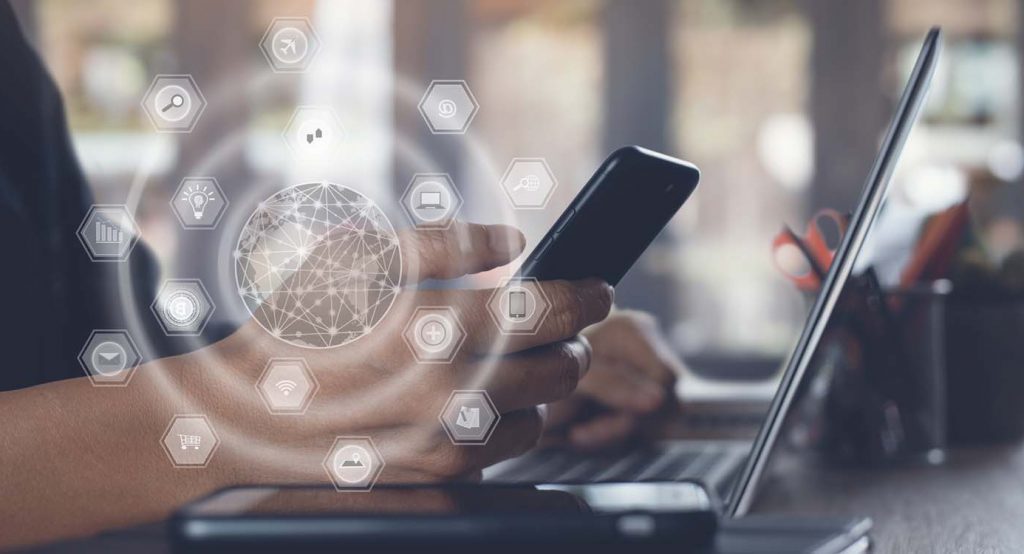
You would do it right away if you could meet the customer service requirements of 90% of your customer base.
The positive news
This is considerably simpler than you might imagine to accomplish with an omnichannel contact center.
Nine out of ten consumers, according to recent research, need an omnichannel communication experience from the businesses they do business with. This is not surprising given that 98% of Americans switch between numerous gadgets every day.
Which is?
That more than 50% of businesses lack an omnichannel communication strategy.
This comprehensive reference to omnichannel contact center solutions will assist you in comprehending the meaning, advantages, and leading suppliers of a seamless customer communication experience.

An Omnichannel Contact Center: What Is It?
An omnichannel contact center is a piece of software that streamlines business communication by instantly updating all channels for customer service and communication.
Regardless of the method of communication, conversations that begin on Facebook Messenger can be immediately converted to SMS texting, a phone call, internet chat, or another channel and continue where they left off.
It is simple for agents to review the whole conversation history before helping the customer because interactions are immediately synchronised across numerous channels. Customers’ enjoyment is increased and a more personalised experience is created when they may choose their preferred way of communication.
For omnichannel cloud contact centers, the following channels are preferred:
- Online conferences
- Real-time messaging on websites
- Telephony
- Text messaging via SMS
- Facebook messaging (Facebook, Instagram, Twitter, etc.)
- Telephonic faxing
Keep in mind that omnichannel contact center solutions and call center software are two different things.
“Contact centers” offer a variety of communication channels, unlike “call centers” which suggest a telephone-first communication strategy. The “most essential” channel will be determined by the trends and consumer behavior of the target market for a company.
In other words, a food delivery service may see that their clients primarily communicate with them via internet chat or SMS text message, whereas a clothing company targeted at millennials may discover that social media is their most popular communication channel.
Omnichannel contact centers are different from multichannel ones, though.
Contact Center Solutions: Omnichannel vs. Multichannel
Multichannel platforms enable connections between customers and enterprises on a variety of communication channels, much like omnichannel contact centers do.
Multichannel communication is less seamless than omnichannel communication.
In a multichannel contact center, email can be utilized as the first step in a customer relationship. The email may contain crucial information like the order and tracking numbers, the best time to reach the customer, and further contact details. An agent begins working on the issue after reading the email. The original email’s author then calls the customer service line and speaks to a different customer service representative from the one who read the email. The multichannel nature of the platform prevents the new agent from having access to or knowledge of any previous interactions.
This suggests that the customer must narrate the same story to multiple agents and that the latter are wasting their time by addressing problems that may already have been fixed. It is clear that poor communication directly correlates to a bad purchasing experience because 89% of customers report that having to repeat yourself to agents is the worst part of their overall customer experience. It also has a significant negative impact on team productivity.
Because client data is synced across channels in real-time, an omnichannel approach implies that all past interactions and notes are visible independent of the channel or the agent engaging with the customer.
Let’s take an example where a consumer visits your website and uses the live online chat feature to contact a product expert with a question about a product. To speak with an expert directly and see the product in use, the customer decides to set up an online video conference. The subsequent product specialist who takes the call will have access to the previous website chat’s transcript. This ensures that they will be well-prepared for the video conference and that the first specialist the customer interacted with via the website chat will be able to track their progress through the customer journey and touchpoints.
The buying process and resolution rates are accelerated through omnichannel communication, which also simplifies customer assistance on all fronts.
An Omnichannel Contact Center’s Advantages
Not only can omnichannel methods benefit your customers, but they also significantly simplify working conditions for your staff.
Top advantages include of:
- higher rates of consumer retention
- shorter response times for customer service
- optimization of a remote workforce
- increased customer customization
Higher Customer Retention Rates
According to recent research, businesses who use omnichannel business communication strategies have customer retention rates that are 91% higher year over year than those that do not.
It’s easy to understand why given the excellent caliber of customer service that omnichannel tools provide.
Customers may communicate on the channel of their choice thanks to omnichannel platforms, which also reduce hold times, eliminate repetition, and boost first call resolution rates (more on that in a minute.)
Given that more than 60% of customers use chat messaging, social media, and self-service tools before calling customer support via phone, consumers today expect a digital-first customer service experience.
Additionally, omnichannel contact centers provide a consistent user experience across all platforms, enhancing brand recognition and facilitating faster customer help.
The team is thus spared from having to learn and recall the use of many communication platforms thanks to a consistent experience.
Shorter times to resolve customer support issues
Today, 80% of consumers want a quick answer to their customer service questions.
The likelihood that a consumer will speak with an agent on their first attempt and that the agent will be the most qualified to assist them increases with the aid of omnichannel contact centers.
Advanced multi-level IVR capabilities offer better consumer self-service features, so in many cases, the customer may fix their own problems without ever needing to speak to a live person. Additionally, this increases employee productivity by allowing agents to handle more critical issues.
Complete customer interaction histories also enable several agents to work on the same support ticket easily and, as was already said, save customers from having to repeat their issues to each agent they speak to, which may be time-consuming.
Empowering Remote Workforce
Any company communication tool should be in line with the requirements of a remote workforce given that around 91% more individuals are working from home now than they did ten years ago.
The possibility that an agent will always be available when a customer contacts you is increased by advanced omnichannel routing options. Compatible mobile apps for Apple and Android smartphones and tablets allow agents to access customer history from anywhere at any time.
Inbound calls are automatically sent to the next available agent in the right department using features like remote call forwarding, which sends calls from an agent’s desk phone to their smartphone or voicemail (or any other predetermined call channel).
While team collaboration software interfaces and APIs enable home-based agents to check project progress, communicate with one another, and even amend documents in real-time, analytics enable remote workforce monitoring.
Additional Personalization
Approximately 55% of merchants claim that delivering a tailored omnichannel consumer experience is the single most important component in strengthening client relationships.
Through the use of automated, personalized text messages, emails, social media posts, and other communications, omnichannel contact centers simplify personalisation. Another significant advantage of omnichannel communication is face-to-face personalisation, particularly when it comes to product recommendations and customer assistance.
Agents are considerably better equipped for calls since they have access to both the full customer history and the specifics of the current engagement. They also know how to deal with those challenging personalities.
Personalized omnichannel strategies promote marketing as well as customer service.
Based on information from prior interactions, you can segment your clientele into various audiences, and you can then present each market group with the kind of marketing that is most likely to connect with them. If you know a customer purchased a subscription that is due to expire or a product that is about to run out, you might offer them a coupon for a product discount or a subscription renewal, for example.
Features of an Omnichannel Contact Center to Consider
After discussing the advantages of omnichannel contact centers, let’s move on to the key characteristics to consider when selecting a platform.

They consist of:
- routing across channels
- analysis of customer sentiment
- integration of business software Analytics and reporting
- employer management
Router for omnichannel
No matter which channels these interactions are started on, admins may define rules for which agents react to consumer enquiries using omnichannel routing, which functions very similarly to call routing.
As opposed to, instance, an IT person who won’t be able to help the client much, a consumer who sends a website chat message asking about a certain product would instantly be sent to the sales department’s available product specialist.
Without having to leave their dashboard and go to the website itself, the agent could type their reply to the chat message once it had instantly shown in their dashboard.
Options for routing include skill-based, round-robin, most idle, and others.
In addition to routing, administrators can provide automated responses that inform clients that their message has been received, provide links to self-help resources, or even predict the length of the wait time. In these automatic responses, chatbots can also be launched. For phone conversations, inbound callers would be routed to an IVR menu that would either connect them to the appropriate agent or enable them finish the conversation by listening to voice commands from a voice bot.
Analysis of customer feedback
To identify words, phrases, and voice patterns that convey a customer’s emotion during a contact, customer sentiment analysis use automated artificial intelligence.
Agents and managers can use it to improve employee training while also getting a better understanding of their client base as a whole.
Customer service terms like “billing,” “order late,” or “refund” are recognized by AI during voice calls using Natural Language Processing (NLP) techniques. This enables managers to understand the most frequent causes for customer support inquiries and what needs improvement.
Customer sentiment analysis also finds key terms and phrases for sentiment analysis in text messages and team discussions. This analysis can also be used to automatically point customer service representatives to certain, pertinent areas of customer service wikis so they can offer better, quicker assistance.
Organizational Software Integration
In an omnichannel contact center, switching between software platforms should be as easy as switching between the different communication channels under a single unified interface.
The following well-known third-party CRM, marketing, team collaboration, and project management technologies will need to be integrated with your contact center:
- Both Zendesk and Salesforce
- Basecamp and Asana
- Mailchimp
- Trello Slack and well-liked Slack substitutes
- GoingToMeeting and Zoom
- Google Suite and Office 365
Reporting and Analytics
Monitoring both current and past communication center KPIs enables administrators to assess departmental and individual agent performance, recognize frequent stumbling blocks, and pinpoint the busiest lines of communication.
Both pre-made, exportable template reports that are automatically performed at certain intervals and customisable reports that let administrators select and monitor their most crucial metrics should be available on communication platforms.
The top analytics are:
- Rates of first-contact resolution
- Average time of a phone or video call
- Interactions per channel, number
- Average daily, weekly, and monthly encounters, both inbound and outward
- Average hold time, transfers, average response time, and callback rates Cost per contact
- Contact drop-off rate
- Rates of overall customer satisfaction and call quality (CSAT score)
- Customer interaction levels
Employer Management
Administrators can build a more effective team by using contact center workforce management (WFM), particularly when combined with analytics.
Assisting is:
- Distribute tasks equally
- Allowing employees to choose their own shifts
- Schedule agents more efficiently
- future trends are predicted
- Observe the availability and activity of the current agent
- Define agent capabilities, ensuring that a representative of each department is always available.
Workflow management tools are typically extras that come with contact center software.
Standard Operating Procedures For Omnichannel Contact Centers
To guarantee you deliver the greatest possible customer experience, we’ll give our best advice for your omnichannel contact center below.
The Best Communication Channels to Use
Although omnichannel contact centers aim to provide customers with a variety of ways to contact your support team, your particular customer base will favor some channels over others.
The key to improving your customer service is to provide the proper amount of resources to each channel based on client preference. Identify where your consumers are most likely to connect and which channels seem to receive related queries by using historical data.
You can find that you’re allocating too many agents to phone help while having a serious deficiency of live website chat assistance.
Upgrade Your Self-Service Options
By 2023, 85% of all customer service engagements, according to Gartner research, will start with self-service.
Better self-service choices make sure that agents can handle more urgent customer support issues and give consumers a speedier overall resolution to their issues.
It makes a tremendous difference to overall customer satisfaction rates to offer self-service options, whether through an interactive call center IVR menu, website chatbots, or even an online knowledge base/tutorial videos.
Keep up with social media
With more than half of customers turning to social media sites like Facebook, Instagram, and Twitter for assistance, social media customer care is expanding.
Social media is also the platform where clients are most likely to go unnoticed, though. According to studies, over 28% of consumers who requested customer support on social media never heard back.
Major benefits come from making more of an effort to support social networking. According to the same study we linked to above, social media agents may respond to 4–8 times more customer inquiries per hour than phone reps.
Make sure you have agents watching social media messages at all times, in addition to sending an automated message to all social media users with an expected response time. Set up omnichannel alerts that cover social media.
A link to the customer’s online knowledge base, details on other ways to contact you (phone, email, etc.), and support hours should all be included in your automated reply.
Make the cross-channel experience consistent
It’s crucial to give customers a consistent experience across all modes of contact in both customer service and sales.
Customers must be able to identify themselves as being in the correct location, feel comfortable using the user interface, and know how to access what they require. Ask yourself if your contact center is genuinely omnichannel if they are unable to.
Start with fundamental consistency in the design, language, and fonts. Then, test the experience to make sure it is consistent across devices, make sure functionality is the same across all channels, and automate real-time omnichannel dialogue syncing.
Schedule Automatic Reports on Client and Agent Behavior
Use the numerous pre-made and customizable statistics and reports, both real-time and historical, that omnichannel contact centers offer.
Key KPIs like average wait time, first call resolution rate, call length, customer churn rate, and customer satisfaction ratings give you a clear picture of how effectively and effectively your customer service is performing.
Agent activity reports highlight which agents may require additional training, highlight training gaps, detail productivity levels, and highlight top performers.
It is simple to set up automated reports that are delivered to your mailbox at the chosen intervals using contact center software.
Make it simple for users to contact live agents
A live customer service agent is preferred by over 90% of customers over an IVR menu that has already been recorded.
As much as you’d like to, especially in high volume contact centers, you can’t always immediately connect a caller with a “real person.”
You may make it simple for clients to reach a live person when necessary by keeping your IVR menus brief and to-the-point. Create warm transfers to link customers to live agents only once they have received basic information about the nature of their inquiry and their contact details. This will keep things moving.
With an omnichannel center, you have the advantage of being able to provide live service over a variety of channels, including chat, SMS, phone, and even video calling. You ought to be able to control the quantity of live agent requests, especially when combined with robust internal knowledge bases and automation (two topics we’ll cover shortly).
Consolidate your internal knowledge base
While keeping employee training current is always necessary, business owners frequently forget one of the most crucial components of a good customer service interaction: your own knowledge base.
Your customers will receive the best and most accurate support possible when your agents have access to thorough internal documents and call scripts.
A comprehensive internal wiki also keeps calls brief and frequently avoids the need to transfer calls to another agent or schedule a follow-up contact. However, it goes beyond simply raising your first call resolution rates.
If your knowledge base is good, agents from different departments will be able to access the scripts and instructions needed to help clients with basic problems if your call volume suddenly increases. A searchable internal wiki has all the information they require.
Automate and use artificial intelligence (AI)
Customers and agents both benefit from significant time savings from AI and automation, which can also reduce customer service expenses by up to 30% for business owners.
We already discussed the significance of offering self-service choices, and AI is one of the greatest methods to achieve this. Natural language processing (NLP) offers thorough customer sentiment analysis and makes sure callers are linked to the best and most pertinent agent that is currently available.
In order to better optimize the workforce, predictive analytics looks at historical customer behavior data to forecast future trends, such as busiest times of the day or year.
By automatically blocking account access in the event of questionable activity, AI and call center automation also aid in preventing fraud and protecting consumers.
Last but not least, merely implementing automated answers that inform clients that their messages have been received has a significant positive impact on client satisfaction.
FAQ
What equipment do I require for contact center software?
Your choice of hardware will be influenced by the many channels you intend to employ. Softphone features also enable contact center agents to place and receive calls on desktop computers and mobile devices, even though businesses typically choose to preserve their traditional office telephones. Hardware components that are essential include routers, webcams that work with them, suitable webcams, and agent headsets.
What possibilities are there for phone numbers with omnichannel communications?
In the vast majority of situations, switching to an omnichannel communication platform will allow you to preserve your present business phone number. A toll-free vanity number and local presence phone numbers are typically also available from carriers.
Can I subsequently add other communication channels?
According to the particular software you select. Some platforms let businesses pick and choose the channels they require and then add on other channels, while others offer bundled channel possibilities as part of tiered plans.
Who ought to make use of omnichannel contact centers?
Although there is a tendency to believe that only enterprise-level, big firms are most suited for omnichannel communication, the truth is that enterprises of any size can profit from the software. Any business, especially SMBs, that interacts with clients across a variety of channels ought to think about switching. In spite of this, contact centers and telemarketing businesses, healthcare organizations, the educational sector, retailers, and software enterprises frequently reap the most rewards.



